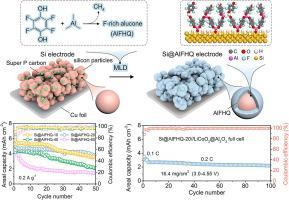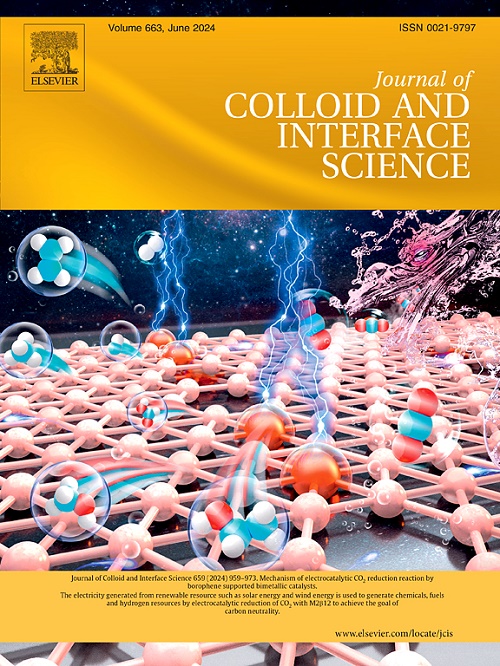Reversible silicon anodes enabled by fluorinated inorganic-organic hybrid coating
IF 9.4
1区 化学
Q1 CHEMISTRY, PHYSICAL
引用次数: 0
Abstract
Silicon anodes deliver batteries with energy densities much higher than those based on today’s dominant graphite anodes. However, they commonly exhibit huge volume variations and unfavorable interface stability, causing a gradually diminishing capacity on extended cycling. Most Si-based batteries consisting Si/C composites in industry can only use a very limited amount of Si (<30 % by weight). Exploiting molecular layer deposition (MLD) technique, a fluorine-rich flexible inorganic–organic hybrid alucone (AlFHQ) shell is controllably deposited onto Si electrodes. Employing ex situ XPS and AFM, the AlFHQ film presents reversible electrochemical evolutions in terms of composition and morphology. The interactions the between Li+ and −O−2,3,5,6-fluorobenzene functional groups help to construct a mechanically-chemically robust LiF-rich hybrid solid electrolyte interphase (SEI) on Si anode, delivering enhanced interfacial stability and integrity of electrode. An optimized coating thickness (≈5 nm) for interfacial stabilization and Li+ transport kinetics is demonstrated, namely, Si@AlFHQ-20. The reported fluorine-rich hybrid modification technique endows (a), stable cycling of Si anode (≈3.8 mAh cm−2) with an ultrahigh initial Coulombic efficiency (ICE) of 92.3 %; (b), enhanced rate capability of 1468 mAh/g at 2.0 A g−1 and good cycling performance; and (c), overall cell (Si@AlFHQ-20//LiCoO2@Al2O3) operational stability for more than 100 cycles under stringent cathode conditions (2.68 mAh cm−2, high cutoff voltage at 4.55 V).

氟化无机-有机混合涂层实现可逆硅阳极
硅阳极电池的能量密度远高于目前主流的石墨阳极电池。然而,硅阳极通常会表现出巨大的体积变化和不利的界面稳定性,导致电池容量在长时间循环后逐渐降低。大多数由硅/碳复合材料组成的硅基电池只能使用非常有限的硅(按重量计为 30%)。利用分子层沉积(MLD)技术,一种富含氟的柔性无机-有机杂化丙酮(AlFHQ)外壳被可控地沉积到硅电极上。利用原位 XPS 和原子力显微镜(AFM),AlFHQ 薄膜在成分和形态方面呈现出可逆的电化学演变。Li+ 与-O-2,3,5,6-氟苯官能团之间的相互作用有助于在硅阳极上构建一个机械化学性质坚固的富含 LiF 的混合固体电解质相(SEI),从而增强了界面稳定性和电极的完整性。针对界面稳定性和 Li+ 传输动力学,展示了一种优化的涂层厚度(≈5 nm),即 Si@AlFHQ-20。所报道的富氟杂化改性技术可(a)实现硅阳极(≈3.8 mAh cm-2)的稳定循环,并具有 92.3 % 的超高初始库仑效率(ICE);(b)在 2.0 A g-1 时的 1468 mAh/g 速率能力和良好的循环性能;以及 (c)在严格的阴极条件下(2.68 mAh cm-2,4.55 V 的高截止电压),电池(Si@AlFHQ-20//LiCoO2@Al2O3)整体工作稳定性超过 100 个循环。
本文章由计算机程序翻译,如有差异,请以英文原文为准。
求助全文
约1分钟内获得全文
求助全文
来源期刊
CiteScore
16.10
自引率
7.10%
发文量
2568
审稿时长
2 months
期刊介绍:
The Journal of Colloid and Interface Science publishes original research findings on the fundamental principles of colloid and interface science, as well as innovative applications in various fields. The criteria for publication include impact, quality, novelty, and originality.
Emphasis:
The journal emphasizes fundamental scientific innovation within the following categories:
A.Colloidal Materials and Nanomaterials
B.Soft Colloidal and Self-Assembly Systems
C.Adsorption, Catalysis, and Electrochemistry
D.Interfacial Processes, Capillarity, and Wetting
E.Biomaterials and Nanomedicine
F.Energy Conversion and Storage, and Environmental Technologies

 求助内容:
求助内容: 应助结果提醒方式:
应助结果提醒方式:


